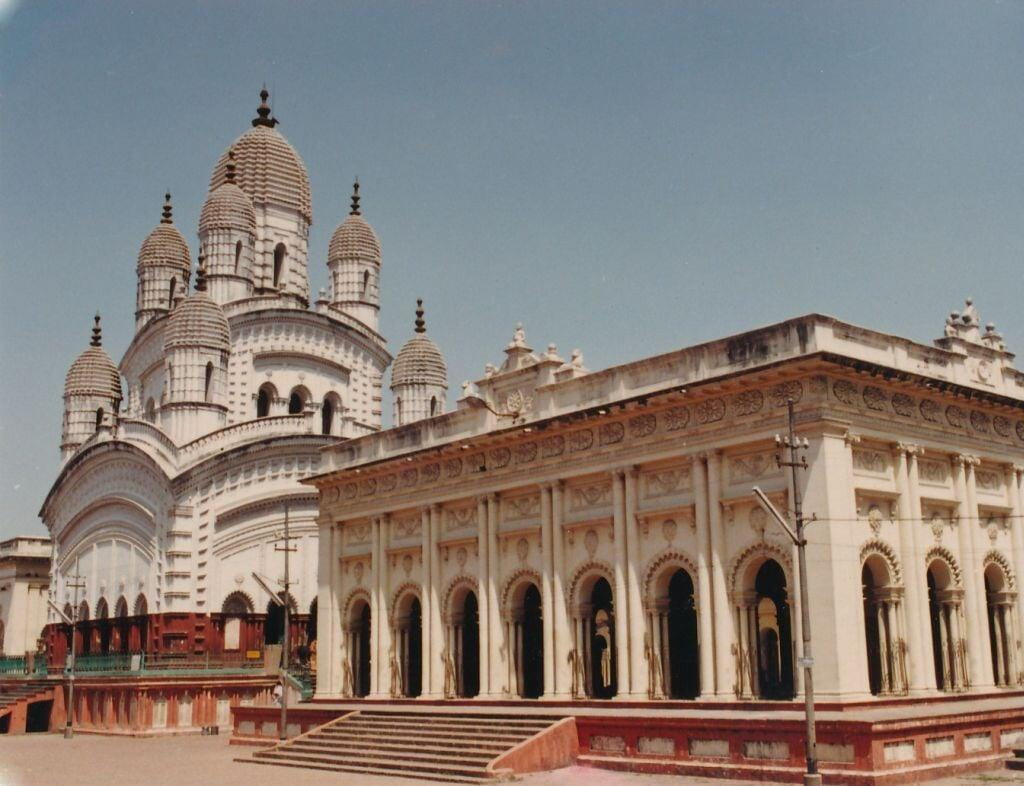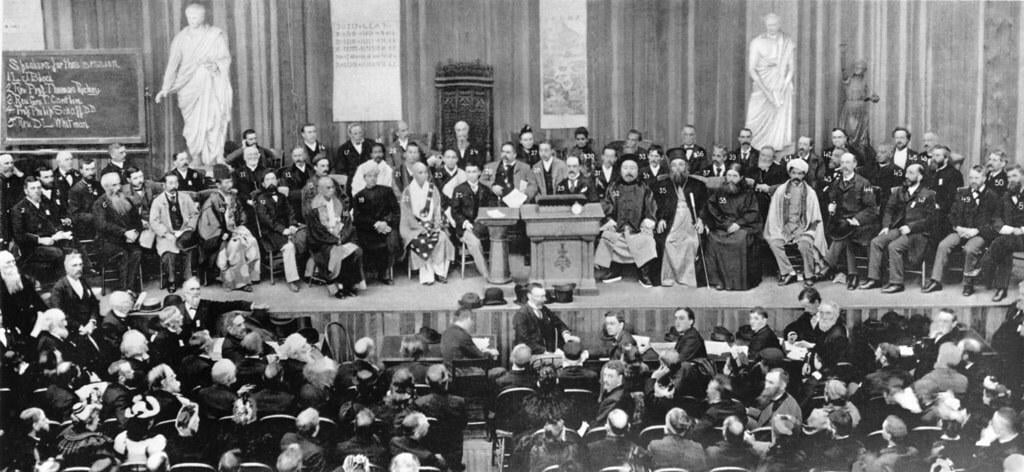Swami Vivekananda
Swami Vivekananda, known in his pre-monastic life as Narendra Nath Datta, was born into an affluent family in Kolkata on 12 January 1863. His father, Vishwanath Datta, was a successful attorney. He was interested in various subjects such as music, travel, literature, cooking etc. His mother, Bhuvaneshwari Devi, was endowed with deep devotion, strong character, and other noble qualities. She believed that Narendra was born to her due to her fervent prayers to Lord Shiva. Everyone in his family and neighbourhood loved him dearly.
A precocious boy, he excelled in music, gymnastics, and studies. He had an exceptional rational intellect, a vivid memory, and a kind heart. By the time he graduated from Scottish Church College, University of Calcutta, he had acquired a vast knowledge of different subjects, especially Western philosophy and history. Born with a religious and yogic temperament, he practised meditation even from his boyhood days and in his youth, he was associated with the Brahmo Movement.
With Sri Ramakrishna
Narendra was a deep thinker, and doubts about God assailed him. Even though he was a regular member of the Brahmo Samaj, he realized that religious lectures and philosophical discussions did not quench his spiritual thirst. He desired to meet someone with a personal and direct experience of seeing God. One of his English professors in college praised Sri Ramakrishna as one who has experienced ecstasy in union with God. Then, one day in November 1881, Narendra met Sri Ramakrishna, who was staying at the Kali Temple in Dakshineshwar. He straightaway asked the Master a question which he had put to several people but to which he had not received a satisfactory answer: “Sir, have you seen God?” Without hesitating, Sri Ramakrishna replied, “Yes, I have seen God. I see Him as I see you here, only more clearly. God can be seen. One can talk to him. But who cares for God? People shed torrents of tears for their wives, children, wealth, and property, but who weeps for the vision of God? If one cries sincerely for God, one can surely see Him.”
Apart from removing doubts from his mind, Sri Ramakrishna won him over through his pure and unselfish love. Thus began a guru-disciple relationship, which is unique in the history of spiritual masters. Narendra now became a frequent visitor to Dakshineshwar and, under the guidance of the Master, made rapid strides on the spiritual path. Sri Ramakrishna taught and trained Narendra for over five years. It culminated in his experience of Nirvikalpa Samadhi, the highest possible yogic experience. At Dakshineshwar, Narendra met several young men devoted to Sri Ramakrishna, and they all became close friends.

The World's Parliament of Religions
After the passing away of Sri Ramakrishna in 1886, his young disciples took monastic vows, and Narendra was now Swami Vivekananda. After some time, Swami Vivekananda left the math to wander across the length and breadth of India and surrendered himself to the Lord. His divine personality and sterling virtues won him admirers wherever he went. In his wanderings, he heard that the World's Parliament of Religions was going to take place in Chicago in 1893. His friends and admirers in India wanted him to attend the Parliament of Religions. He also felt that it would provide an ideal forum to present the message of Sri Ramakrishna to the world. Another reason which prompted Swamiji to go to America was to seek financial help for his project of uplifting the masses. With these motives, he decided to go to America. Swamiji, however, wanted an inner certitude and a divine call regarding his mission. He got clarity regarding them when he sat in deep meditation on the rock island at Kanyakumari (he also sought and received Holy Mother’s blessings—this should probably be mentioned!). With funds collected by his Chennai disciples as well as provided by the Raja of Khetri, Swami Vivekananda left for America from Mumbai on 31 May 1893.

The Parliament of Religions and After
His speeches at the Parliament of World's Religions, held in September 1893, made him famous as an orator by divine right and a Messenger of Indian wisdom to the Western world. After the Parliament, Swamiji spent nearly three and a half years spreading Vedanta as lived and taught by Sri Ramakrishna, mostly in the eastern parts of the USA and also in London.
Foundation of Ramakrishna Mission
Soon after his return to Kolkata, Swami Vivekananda accomplished another important task of his mission on earth. He founded on 1 May 1897 a unique organization known as the Ramakrishna Mission, in which monks and lay people jointly undertake to implement the teachings of Vedanta in day-to-day life by conducting various forms of social service activities, such as running hospitals, schools, colleges, hostels, rural development centres etc., as well as massive relief and rehabilitation work for victims of earthquakes, cyclones and other calamities, in different parts of India and other countries.
Belur Math
In early 1898, Swami Vivekananda acquired a big plot of land on the western bank of the Ganga at a place called Belur to have a permanent abode for the math first started at Baranagar, and got it registered as Ramakrishna Math after a couple of years. Swamiji established a new, universal pattern of monastic life that adapts ancient ideals to the conditions of modern life; gives equal importance to personal illumination and social service; and is open to all men without any distinction of religion, race or caste.
Disciples
The message of Swami Vivekananda influenced many people in the West. Some of them became his disciples or devoted friends. Margaret Noble (later known as Sister Nivedita), Sister Christine, Captain and Mrs Sevier, Josephine McLeod, and Sara Chapman Bull were most notable among them. Nivedita dedicated her life to educating girls in Kolkata. Swamiji had many Indian disciples, some of whom joined Ramakrishna Math and became monks.

Last Days
In June 1899, he went to the West on a second visit. This time he spent most of his time on the West Coast of the USA. After delivering many lectures, he returned to Belur Math in December 1900. He spent the rest of his life in India, inspiring and guiding monastic and lay persons. Incessant work, especially giving lectures and inspiring people, told upon his health. His health deteriorated, and the end came quietly on the night of 4 July 1902. Before his Mahasamadhi, he wrote to a Western follower, "It may be that I shall find it good to get outside my body, to cast it off like a worn-out garment. But I shall not cease to work. I shall inspire men everywhere until the whole world shall know that it is one with God."

Important Teachings of Sri Ramakrishna
1. Each soul is potentially divine. The goal is to manifest this Divinity by controlling nature, external and internal. Do this either by work or worship or psychic control or philosophy — by one, or more, or all of these — and be free. This is the whole of religion. Doctrines or dogmas or rituals or books or temples or forms are but secondary details.
2. Can religion accomplish anything? It can. It brings man to eternal life. It has made man what he is and will make this human animal a God. This is what religion can do. Take religion from human society, and what will remain? Nothing but a forest of brutes.
3. This religion is attained by Yoga — union. To the worker, it is the union between men and the whole of humanity; to the mystic, between his lower and Higher Self, to the lover, between himself and the God of Love; and to the philosopher, it is the union of all existence.
4. That which is selfish is immoral, and that which is unselfish is moral. Unselfishness is more paying; only people have not the patience to practise it.
5. Meditation is one thing. Meditate! The greatest thing is meditation. It is the nearest approach to spiritual life—the mind meditating. It is the moment in our daily life that we are not material—the soul thinking of itself, free from all matter—this marvellous touch of the soul.
6. It is love and love alone that I preach, and I base my teaching on the great Vedantic truth of the sameness and omnipresence of the Soul of the Universe.
7. Those who give themselves up to the Lord do more for the world than all the so-called workers. One man who has purified himself thoroughly accomplishes more than a regiment of preachers. Out of purity and silence comes the word of power.
8. Take up one idea. Make that one idea your life; think of it; dream of it; live on that idea. Let the brain, muscles, nerves, and every part of your body be full of that idea and leave every other idea alone. This is the way to success, and this is the way great spiritual giants are produced.
9. If there is a God, we must see Him; if there is a soul, we must perceive it; otherwise it is better not to believe. It is better to be an outspoken atheist than a hypocrite.
10. Men, men, these are wanted; everything else will be ready, but strong, vigorous, believing young men, sincere to the backbone, are wanted. A hundred such and the world becomes revolutionized.
Recommended for further reading
1. Life of Swami Vivekananda by Eastern and Western Disciples, Two Volumes. Kolkata: Advaita Ashrama
2. The Complete Works of Swami Vivekananda, Nine Volumes. Kolkata: Advaita Ashrama
3. The Life of Vivekananda by Romain Rolland, tr. E.K. Malcolm Smith. Kolkata: Advaita Ashrama.
4. Teachings of Swami Vivekananda. Kolkata: Advaita Ashrama
5. Swami Vivekananda’s Speeches at the Parliament of Religions, Chicago, 1893

